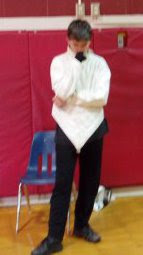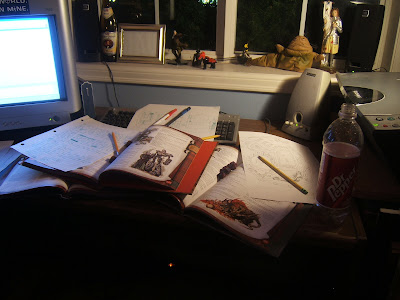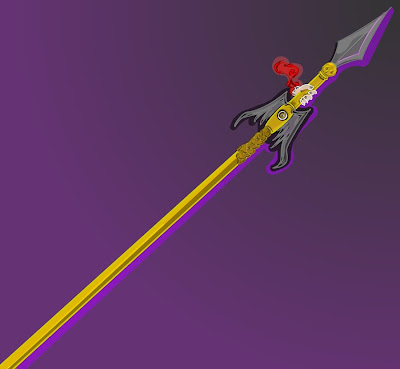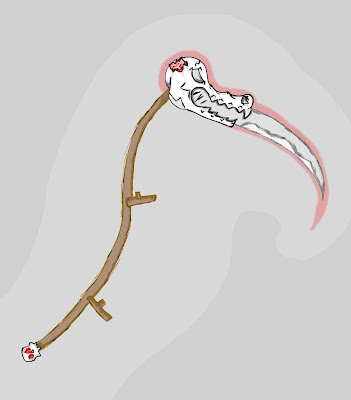
When I was young, I liked to play pretend. When we're young, we all do. I played "Star Wars" a lot, putting myself into the role of Luke Skywalker, waving sticks around and making "vroosh!" noises with my mouth. As I got a little older, and my friends started to be more interested in bicycles and video games, I continued to enjoy playing pretend. Which isn't to say I didn't love video games or bicycles. I distinctly remember being a member of a "biker gang" which wasn't allowed to cross any streets, so we just rode around the block over and over. But while my friends
stopped playing pretend,
my fantasies only became more elaborate. I even started making up my own characters, drawing pictures of them, and writing notes about their various abilities and weapons. Looking back on it, these pieces of paper were proto-character sheets.
I owe it to
Bill Amend, the brilliant cartoonist behind the long-running syndicated comic strip Fox Trot, for first introducing me to the concept of tabletop role playing games. You see, one of my other passions as a young child was reading the comic strips in the daily newspaper. Even after my family stopped having the paper delivered, because my parents didn't have time to read it, I convinced my grandmother to save the comic page for me. I even kept all of the comic pages in a box under my bed. If you're not familiar with Fox Trot, one of the primary characters is ten year old Jason Fox, a geeky kid who excels academically, and is passionate about many "nerdy" pursuits. I can't recall precisely when, but at some point during my childhood the strip featured Jason and his friend Marcus playing Dungeons and Dragons. The game wasn't mentioned by name, but the core elements were all on display: a dungeon master's screen, dice, and the DM weaving a world for the player's character to explore.

The notion intrigued me. I was too young then to remember what precisely went through my mind, but I knew that whatever they were doing looked fun, and I wanted to play too. I constructed a GM screen out of black construction paper, and glued little pieces of note paper to the inside of it. On the note paper, I wrote the rules I had made up for the game. I also recall creating small tokens--doodles on pieces of paper--to represent adventurers and monsters. I also had a bowl with numbered scraps of paper to take the place of the dice. My parents warned me that the game I was emulating was an evil one--which would prove to be a major point of contention later in my life. But, to their credit, they didn't go so far as to forcibly stop me from pursuing the project. I spent at least a few days working on my primitive version of D&D, but never really figured out how to make all the elements come together into a cohesive game. Nor could I convince any of my siblings to play with me. Eventually I gave up and largely forgot about the project, as kids are apt to do.
Eventually I joined my friends in growing out of playing pretend--though I never did stop quietly imagining myself to be someone else. That's something I still do to this day. But so far as role playing is concerned, I didn't take my next step until I was about 14 years old. That's when my family finally got an Internet connection, and an entire
world outside of my orthodox catholic homeschooler existence opened up. Writing about my history with the Internet and the impact it had on my life could be a whole other post altogether. But what's important is that it didn't take long for me to break my parents rule about never talking to other people on the Internet. In short order I found forums, and on forums, I found people role playing.
It was awful. The role plays I participated in those days were all themed around the Legend of Zelda mythos, yet most of the players were playing Final Fantasy characters. Not ripoffs mind you, characters like Auron, Sephiroth, and Red XIII were (for some reason) determined to save Hyrule. I hesitate to even mention the character I played, because I don't think anyone directly involved remembers, but my character was actually named "Link Skywalker." He traveled through dimensions living through other people's lives. After living through someone's life, he had all of their abilities and equipment. I honestly cannot tell you how tempted I am to simply edit this paragraph out and let my readers go on blissfully unaware of how shamefully bad my early role playing was.

It was around this same time that I joined a saber fencing class, which may seem irrelevant. However, this is the class where I first met Jeremy. He was quite a bit older than me, and in the advanced class, but we connected over our shared nerdiness. It wasn't long before we spent more time talking than we did fencing, and I eventually learned that he played Dungeons and Dragons. I had always been interested in D&D, since I realized it was what Jason and Marcus had been playing in that old Fox Trot comic. However, my parents had made it very clear to me that such games were strictly forbidden--not just by them, but by "almighty god." I wasn't really convinced that D&D was evil, but at that time I was scared enough of my parents that I didn't pursue the topic further.
My forum role playing continued for several years, and the quality of it improved a great deal. I abandoned my original character almost immediately in favor of one I dubbed Beloch Shrike (partially after the villain from
Raiders of the Lost Arc, and partially after the villain from
The Paradise Snare by A.C. Crispin.) The rest of the group similarly matured, and we experimented with a lot of different things. Some of the most important friendships of my life were formed during these early role playing experiences. Eventually, I even attempted to start a website, titled Epic Journeys, which would serve as a nexus of tools, information, and guides to help people facilitate running their own forum role plays. The project never really got off the ground, though I did actually manage to accomplish one thing. As part of the project, I coined the term "Online Text Based Role Playing Game," or "OTBRPG," and added it to Wikipedia (not then fully aware that this was a serious violation of Wikipedia's rules.) Not only was the article
never removed, but I have since actually met people who use the term without knowing I invented it. Seriously, google it. The phrase has entered somewhat common usage. This never ceases to crack me up, but I digress.

Everything changed for me, quite suddenly, in the last half of 2004. I was seventeen, still heavily involved in forum role playing, and starting to develop a taste for philosophy. My continued interest in Dungeons and Dragons led me to begin looking through the Catechism of the Catholic Church (big book o' rules) looking for any mention of role playing or D&D. After finding
none, I went online and found a forum dedicated to Catholics discussing their faith. I asked them what they thought about D&D being evil, and if you want to see something hilarious,
the entire thread is still online and available to read. (Though apparently it now shows up as an unsafe link in most browsers. As best I can tell it is still safe to visit.) Most of the answers from other posters seemed to agree that there was nothing inherently wrong with D&D, so I printed the thread out and proudly presented it to my parents. After reading the printout, however, they summarily denied my request to be allowed to play the game. My parents were pretty terrifying people, and I grudgingly obeyed them.
Two months later, in September, I met Stephanie, and the changes in my life accelerated. We had a lot in common, including a shared interest in Dungeons and Dragons. At that time I had still never played, and she had played only once or twice. I won't go into the details of our relationship, as is still somewhat painful, and certainly outside this blog's subject matter. Suffice to say that I was head over heels. By November we were dating, and the relationship lasted for six years. In those early days of our relationship, I did a lot of things in order to spend more time with her. I bought a copy of Starcraft so we could have Battle.net dates. And, more relevantly, I took my fencing buddy Jeremy up on his standing offer to borrow his copy of the Dungeons and Dragons third edition core rulebooks. I hid them under some papers in the bottom drawer of my filing cabinet. Most kids are probably hiding weed, booze, porn and sex from their parents when they're 17. I was hiding role playing sourcebooks. Some might see it as sad, but I'm actually rather proud of that.

The first little bit of D&D I ever played was with Stephanie. It was bad. I GMed a really short adventure for her where she fought a mummy. I didn't understand any of the rules, and I was throwing stats around left and right without any idea what they meant. Fortunately, my parents and the rest of my family were out of town the following week, so Jeremy came over to give me a proper introduction to the game. Again: most kids throw drinking parties when they're seventeen and their parents are out of town. I threw an adventuring party, and I'm proud of that. When Jeremy arrived he brought a gift with him: my own set of dice. They were a deep red with blue flecks, and they came in a plastic cylinder. He also brought with him his brand-new 3.5 edition core rulebooks, helped me roll up my very first rogue, and ran me through a simple Colosseum adventure where I fought some green needle monster things. It was glorious.
I continued in that way for quite some time. I purchased my own copies of the 3.5 rulebooks, and Jeremy would GM for me at his home. His ladyfriend, Jacie, eventually joined me as a gnomish cleric, and the two of us had many fine adventures together. I don't remember how long it took for my parents to find out, likely just a few months if I remember correctly. I had just returned from a game at Jeremy's, and went to find them to let them know I was home, my laptop bag filled with D&D supplies still in hand. They looked at me funny, and asked what I did when I was over at Jeremy's. I tried to be nonchalant, and told them that we mostly just played games. They responded;
"Do you play Dungeons and Dragons?"
"Yes," I said.
They didn't really react much at all to that. Merely nodded and seemed to accept that this was a thing I was doing now. I never have been able to tell what things will make my parents angry and what things they can accept. For awhile I thought that, perhaps, they had mellowed out a bit, and become more accepting. That notion was proven wrong recently, when I asked them if I could buy my younger brother the Pathfinder Beginner Box for Christmas. They denied my request, adding that they didn't like what "those types of games" had already done to one of their children.
Cest'la vie.

Never the less, I took my books out from the bottom drawer of my filing cabinet, and placed them lovingly on one of my bookshelves.
Jeremy and I continued to play together, and I tried my hand at GMing several times. I've always loved crafting worlds. In fact, as a young child I used to spend a lot of time drawing complex maps for a monster-filled series of caverns.* I was born to be a GM, but running games for one person can be a limiting experience. I needed a larger group, but I had been home schooled since the fourth grade, and didn't really have the social tools to make friends. At least, that is, until I enrolled in college for the Fall 2005 semester. College is supposedly an eye opening experience even for kids who attended an actual school, so you can imagine what a change it was for me. I met so many wonderful people there, including Chris and Jeremy. They were my first gaming group. I was so happy to finally have one that I actually purchased Player's Handbooks for both of them. We had some great games together, and they even invited some of their own friends along, giving me a nice full party to work with.

To repeat an old cliche, the rest is history. Gaming groups have come and gone, and there have often been weeks or months at a time when I don't get to play, but my love for the game always remains. It's been over seven years since I picked up my first sourcebook--which seems like such a short amount of time compared to the lifetime I feel I've lived as a gamer. Jeremy plays in most of my games, and still serves as my GM whenever we play
Zalekios. And if there's anything I've learned, it's that there will always be people out there who want to play games. All they need is someone to suggest it, and be willing to show them how it's done.
*Holy shit. I can't believe I never thought of using these old drawings as a dungeon for my players before. I know exactly where they are.
 I'm not sure if I've mentioned this in the past, but I'm a huge fan of oldschool Final Fantasy games. Any numbered games X or prior are great, but IV, VI, VII, and VIII are my favorites by far. Amusingly, I've never really had a taste for western RPGs of the video game variety, such as the Elder Scrolls series, or Mass Effect games. They much more closely emulate my one true love--tabletop games--but I think there's a sort of "uncanny valley" effect for me. I like linear games, and I like games with true tactical infinity, but games which emulate tactical infinity without actually giving me infinite options can just be frustrating.
I'm not sure if I've mentioned this in the past, but I'm a huge fan of oldschool Final Fantasy games. Any numbered games X or prior are great, but IV, VI, VII, and VIII are my favorites by far. Amusingly, I've never really had a taste for western RPGs of the video game variety, such as the Elder Scrolls series, or Mass Effect games. They much more closely emulate my one true love--tabletop games--but I think there's a sort of "uncanny valley" effect for me. I like linear games, and I like games with true tactical infinity, but games which emulate tactical infinity without actually giving me infinite options can just be frustrating. The tanks make a few more appearances throughout the game, and the idea intrigued me. I am apparently not alone in this, because both the Warcraft and Warhammer franchises employ dwarves with tanks. Perhaps it's because the race themselves--short, squat, and unimaginably tough--fundamentally resemble tanks. Whatever the reason, I decided that dwarven tanks would make a great addition to my D&D games. However, I'm not a huge fan of including technology in fantasy games. It can be a fun twist for a setting, but as a general rule I like the most advanced technology in my games to be a crossbow. So the challenge was to create a dwarven tank which didn't rely on technology, but also did not rely on an excessive use of magic, since dwarves would probably find distasteful. This is what I came up with. Lali-ho!
The tanks make a few more appearances throughout the game, and the idea intrigued me. I am apparently not alone in this, because both the Warcraft and Warhammer franchises employ dwarves with tanks. Perhaps it's because the race themselves--short, squat, and unimaginably tough--fundamentally resemble tanks. Whatever the reason, I decided that dwarven tanks would make a great addition to my D&D games. However, I'm not a huge fan of including technology in fantasy games. It can be a fun twist for a setting, but as a general rule I like the most advanced technology in my games to be a crossbow. So the challenge was to create a dwarven tank which didn't rely on technology, but also did not rely on an excessive use of magic, since dwarves would probably find distasteful. This is what I came up with. Lali-ho!











